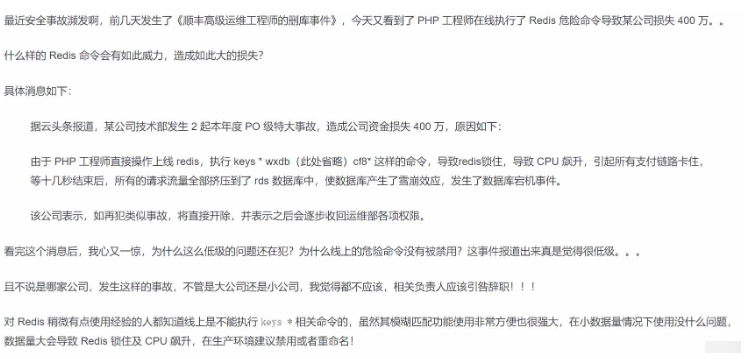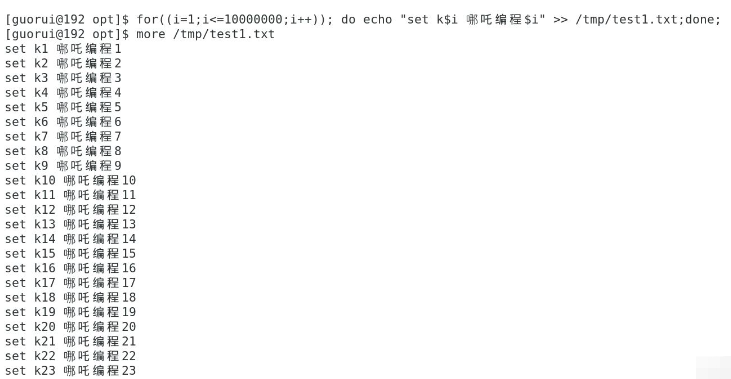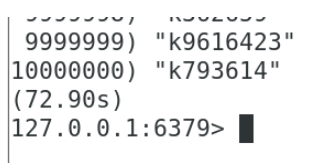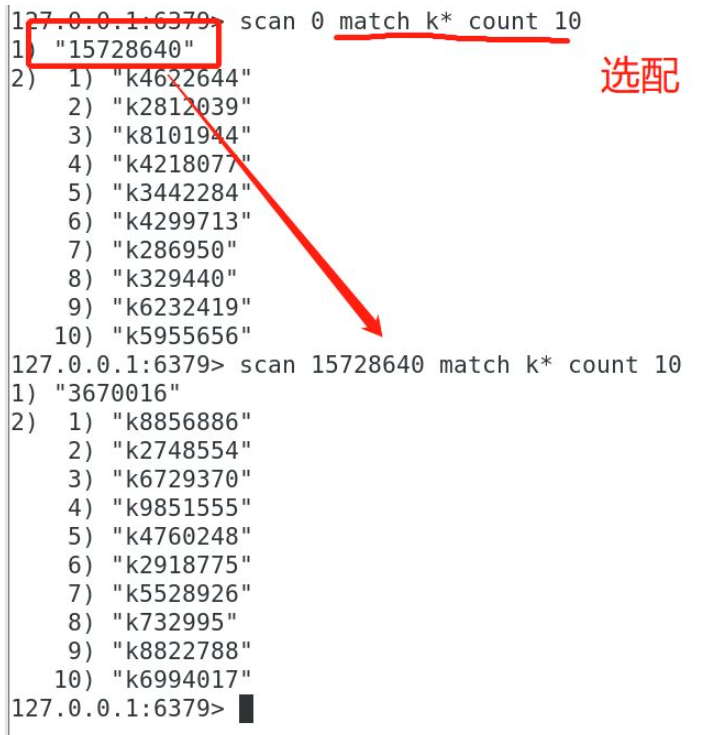How to solve the problem that Redis bigkeys command will block
1. An SF Express senior development engineer executed a dangerous Redis command online, causing a company to lose 4 million.

One command resulted in a loss of millions. Does this require compensation?
The code is not standardized and my colleagues burst into tears. Please be careful when coding!
Out of curiosity, let me test it out. What is the problem?
2. Test the performance of 10 million data
1. Write a script file
Write 10 million data.
for((i=1;i<=10000000;i++)); do echo "set k$i 哪吒编程$i" >> /tmp/test1.txt;done;
Check whether the writing is successful through /tmp/test1.txt.

2. Write 10 million data to Redis
cat /tmp/test1.txt | redis-cli -a 111111 --pipe

3. View 10 million data through keys *

4. Prohibit the use of keys * through the configuration file
Configure security in the redis.conf file:
rename- command keys "" rename- command flushdb "" rename- command flushall ""
3. Use scan instead of keys *
The Redis Scan command is used to iterate over database keys in the database.
The SCAN command is a cursor-based iterator. Each time it is called, a new cursor will be returned to the user. The user needs to use this new cursor as the cursor parameter of the SCAN command in the next iteration. In this way to continue the previous iterative process.
SCAN returns an array containing two elements. The first element is the new cursor for the next iteration, and the second element is an array containing all the iterated items. element. If the new cursor returns 0 it indicates that the iteration has ended.
scan syntax:
SCAN cursor [MATCH pattern] [COUNT count]

4. Reject bigkey
1. Alibaba Cloud Redis development specifications
Alibaba Cloud The Redis development specifications clearly stipulate"Reject bigkey (prevent network card traffic and slow queries)".
String type is controlled within 10KB, and the number of hash, list, set, and zset elements should not exceed 5000.
2. How to delete bigkey when it appears?
String type is deleted with del.
Other types use hscan, sscan, and zscan methods to progressively delete. At the same time, the problem of automatic deletion of bigkey expiration time must be avoided, because it will cause the main thread to block.
Hash Delete: hscan hdel
public void delBigHash(String host, int port, String password, String bigHashKey) {
Jedis jedis = new Jedis(host, port);
if (password != null && !"".equals(password)) {
jedis.auth(password);
}
ScanParams scanParams = new ScanParams().count(100);
String cursor = "0";
do {
ScanResult<Entry<String, String>> scanResult = jedis.hscan(bigHashKey, cursor, scanParams);
List<Entry<String, String>> entryList = scanResult.getResult();
if (entryList != null && !entryList.isEmpty()) {
for (Entry<String, String> entry : entryList) {
jedis.hdel(bigHashKey, entry.getKey());
}
}
cursor = scanResult.getStringCursor();
} while (!"0".equals(cursor));
//删除 bigkey
jedis.del(bigHashKey);
}3. What problems will bigkey cause?
Memory is uneven, cluster migration is difficult;
Timeout deletion, blocking threads;
Network traffic is blocked;
4. How to find bigkey?
(1) Search through redis-cli --bigkeys.

(2) Calculate the number of bytes of each key value and search through the memory usage key

The above is the detailed content of How to solve the problem that Redis bigkeys command will block. For more information, please follow other related articles on the PHP Chinese website!

Hot AI Tools

Undresser.AI Undress
AI-powered app for creating realistic nude photos

AI Clothes Remover
Online AI tool for removing clothes from photos.

Undress AI Tool
Undress images for free

Clothoff.io
AI clothes remover

Video Face Swap
Swap faces in any video effortlessly with our completely free AI face swap tool!

Hot Article

Hot Tools

Notepad++7.3.1
Easy-to-use and free code editor

SublimeText3 Chinese version
Chinese version, very easy to use

Zend Studio 13.0.1
Powerful PHP integrated development environment

Dreamweaver CS6
Visual web development tools

SublimeText3 Mac version
God-level code editing software (SublimeText3)

Hot Topics
 How to build the redis cluster mode
Apr 10, 2025 pm 10:15 PM
How to build the redis cluster mode
Apr 10, 2025 pm 10:15 PM
Redis cluster mode deploys Redis instances to multiple servers through sharding, improving scalability and availability. The construction steps are as follows: Create odd Redis instances with different ports; Create 3 sentinel instances, monitor Redis instances and failover; configure sentinel configuration files, add monitoring Redis instance information and failover settings; configure Redis instance configuration files, enable cluster mode and specify the cluster information file path; create nodes.conf file, containing information of each Redis instance; start the cluster, execute the create command to create a cluster and specify the number of replicas; log in to the cluster to execute the CLUSTER INFO command to verify the cluster status; make
 How to clear redis data
Apr 10, 2025 pm 10:06 PM
How to clear redis data
Apr 10, 2025 pm 10:06 PM
How to clear Redis data: Use the FLUSHALL command to clear all key values. Use the FLUSHDB command to clear the key value of the currently selected database. Use SELECT to switch databases, and then use FLUSHDB to clear multiple databases. Use the DEL command to delete a specific key. Use the redis-cli tool to clear the data.
 How to read redis queue
Apr 10, 2025 pm 10:12 PM
How to read redis queue
Apr 10, 2025 pm 10:12 PM
To read a queue from Redis, you need to get the queue name, read the elements using the LPOP command, and process the empty queue. The specific steps are as follows: Get the queue name: name it with the prefix of "queue:" such as "queue:my-queue". Use the LPOP command: Eject the element from the head of the queue and return its value, such as LPOP queue:my-queue. Processing empty queues: If the queue is empty, LPOP returns nil, and you can check whether the queue exists before reading the element.
 How to use the redis command
Apr 10, 2025 pm 08:45 PM
How to use the redis command
Apr 10, 2025 pm 08:45 PM
Using the Redis directive requires the following steps: Open the Redis client. Enter the command (verb key value). Provides the required parameters (varies from instruction to instruction). Press Enter to execute the command. Redis returns a response indicating the result of the operation (usually OK or -ERR).
 How to use redis lock
Apr 10, 2025 pm 08:39 PM
How to use redis lock
Apr 10, 2025 pm 08:39 PM
Using Redis to lock operations requires obtaining the lock through the SETNX command, and then using the EXPIRE command to set the expiration time. The specific steps are: (1) Use the SETNX command to try to set a key-value pair; (2) Use the EXPIRE command to set the expiration time for the lock; (3) Use the DEL command to delete the lock when the lock is no longer needed.
 How to configure Lua script execution time in centos redis
Apr 14, 2025 pm 02:12 PM
How to configure Lua script execution time in centos redis
Apr 14, 2025 pm 02:12 PM
On CentOS systems, you can limit the execution time of Lua scripts by modifying Redis configuration files or using Redis commands to prevent malicious scripts from consuming too much resources. Method 1: Modify the Redis configuration file and locate the Redis configuration file: The Redis configuration file is usually located in /etc/redis/redis.conf. Edit configuration file: Open the configuration file using a text editor (such as vi or nano): sudovi/etc/redis/redis.conf Set the Lua script execution time limit: Add or modify the following lines in the configuration file to set the maximum execution time of the Lua script (unit: milliseconds)
 How to use the redis command line
Apr 10, 2025 pm 10:18 PM
How to use the redis command line
Apr 10, 2025 pm 10:18 PM
Use the Redis command line tool (redis-cli) to manage and operate Redis through the following steps: Connect to the server, specify the address and port. Send commands to the server using the command name and parameters. Use the HELP command to view help information for a specific command. Use the QUIT command to exit the command line tool.
 How to set the redis expiration policy
Apr 10, 2025 pm 10:03 PM
How to set the redis expiration policy
Apr 10, 2025 pm 10:03 PM
There are two types of Redis data expiration strategies: periodic deletion: periodic scan to delete the expired key, which can be set through expired-time-cap-remove-count and expired-time-cap-remove-delay parameters. Lazy Deletion: Check for deletion expired keys only when keys are read or written. They can be set through lazyfree-lazy-eviction, lazyfree-lazy-expire, lazyfree-lazy-user-del parameters.






